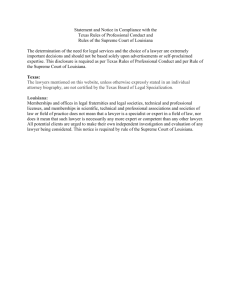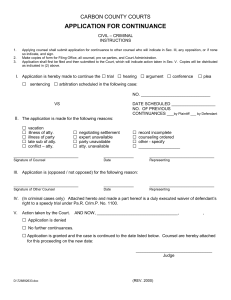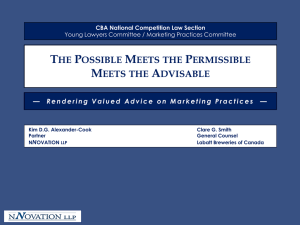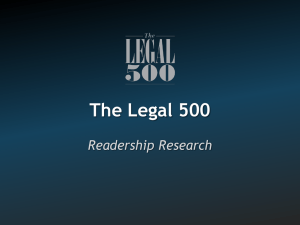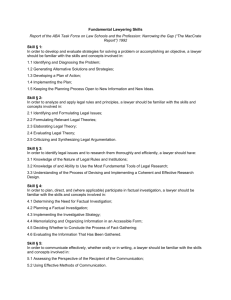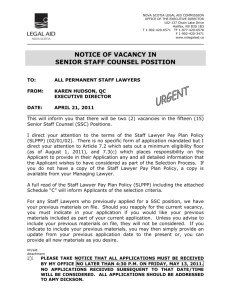Professional Responsibility
advertisement
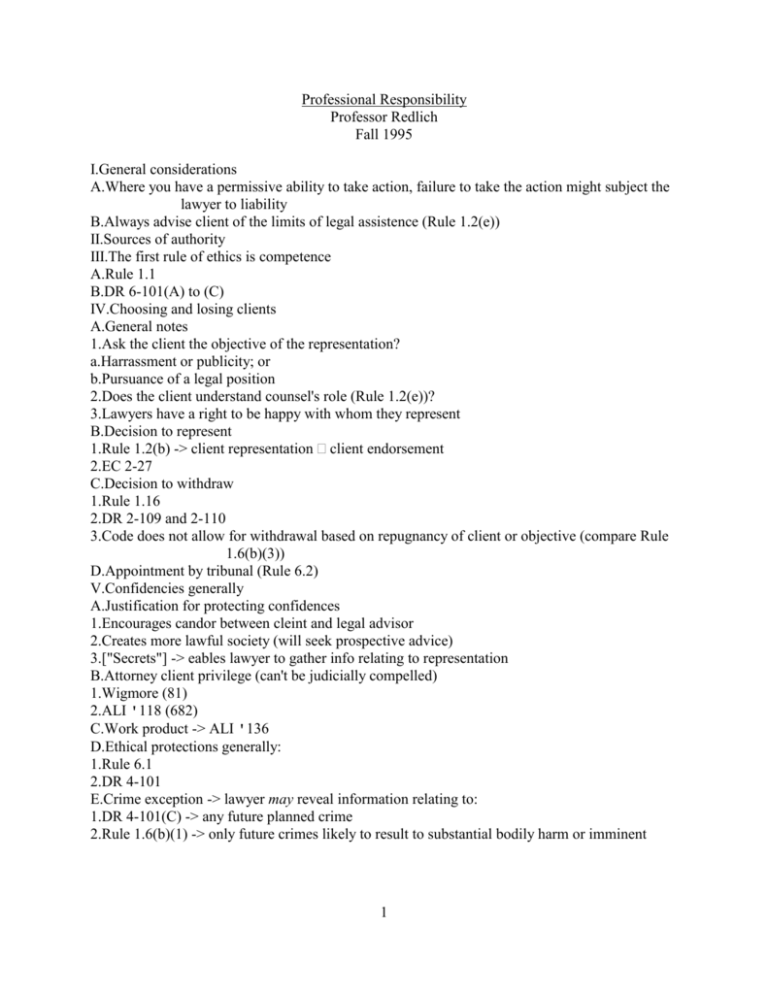
Professional Responsibility Professor Redlich Fall 1995 I.General considerations A.Where you have a permissive ability to take action, failure to take the action might subject the lawyer to liability B.Always advise client of the limits of legal assistence (Rule 1.2(e)) II.Sources of authority III.The first rule of ethics is competence A.Rule 1.1 B.DR 6-101(A) to (C) IV.Choosing and losing clients A.General notes 1.Ask the client the objective of the representation? a.Harrassment or publicity; or b.Pursuance of a legal position 2.Does the client understand counsel's role (Rule 1.2(e))? 3.Lawyers have a right to be happy with whom they represent B.Decision to represent 1.Rule 1.2(b) -> client representation client endorsement 2.EC 2-27 C.Decision to withdraw 1.Rule 1.16 2.DR 2-109 and 2-110 3.Code does not allow for withdrawal based on repugnancy of client or objective (compare Rule 1.6(b)(3)) D.Appointment by tribunal (Rule 6.2) V.Confidencies generally A.Justification for protecting confidences 1.Encourages candor between cleint and legal advisor 2.Creates more lawful society (will seek prospective advice) 3.["Secrets"] -> eables lawyer to gather info relating to representation B.Attorney client privilege (can't be judicially compelled) 1.Wigmore (81) 2.ALI '118 (682) C.Work product -> ALI '136 D.Ethical protections generally: 1.Rule 6.1 2.DR 4-101 E.Crime exception -> lawyer may reveal information relating to: 1.DR 4-101(C) -> any future planned crime 2.Rule 1.6(b)(1) -> only future crimes likely to result to substantial bodily harm or imminent 1 death F.General rules against client frauds on others 1.DR 7-102(B) 2.Rule 4.1 3.Rules don't require disclosure of client confidences in these situations because rules are only drafted to prevent lawyers from furthering harm, not to prevent others from doing so G.Noisy withdrawal -> used where attorney's work product is used to assist client fraud (so think "transactional" context) 1.Rule structure a.Rule 1.2(d) -> no assisting client to commit fraud b.Rule 1.16(a)(1) -> withdrawal is required where continued representation would violate rules or law c.Rule 1.6 cmt. 14 & 15 -> lawyer may announce fact of withdrawal and may disavow prior work product 2.Criticisms: a.Gives comments the weight of rules b.If lawyer is compelled to withdrawal, why shouldn't a noisy withdrawal be required as well c.Is it proper to define "assistence" as continued availability of prior work product VI.Remedying a fraud on a tribunal A.Why do the Rules require disclosure of confidences for frauds on tribunals but not for frauds on third parties? 1.Integrity of the legal system; lawyers as officers of the court 2.Inability of the lawyer to withdraw from representation at that time B.What do you do if the client want to testify falsely? 1.Rule 1.2(e) -> tell client limits of legal assistence 2.Tell client you're required to tell court of perjury if client commits it 3.After you do this, you can call client on to the stand without violating 3.3(a)(4); you don't know client will perjure himself 4.You can call client and just ask him questions you think will be truthful 5.If you don't call client, you risk ineffective assistence of counsel C.Nix v. Whiteside: 1.6th Amendment assistence of counsel and right to testify in own defense does not include false testimony or assistence in promulgating it 2.But code pulls you in two directions at once: (DR 7-102) a.It bars you from revealing confidences even in the face of perjury. b.But it bars you from using perjured testimony c.To satisfy rules, client can tell his story in a narrative form, without assistence from attorney, and without attorney using client testimony in closing argument D.Rule 3.3 applies to statements in the discovery process (Op. 93-376) VII.Use of inadvertently disclosed confidences A.ABA Op. 92-368 -> inadvertent disclosure (fax to wrong place) B.ABA Op. 94-382 -> unsolicited receipt of privileged material (anonymous tip) 2 C.What do you do? 1.Look at materials only in order to determine how to procede (is the info ethically protected?) 2.Notify adverse party or lawyer that you have the document, and follow their instructions 3.Where there's a dispute (i.e., should have been part of discovery), go to court D.If you have to give the info. back 1.You can't use the info and the fruits you get from the info. (stuff you wouldn't have gotten but for the info) 2.You may be disqualified because of your knowledge VIII.Law firm practice -- Rules 5.1 - 5.3 IX.Representation of the corporate client (code is useless): Rule 1.13 A.Legal violations by a corporate client 1.First thing you should do is advise client to stop violation 2.If lawyer's services are being used to further crime: (cmt. 6) a.Rule 1.2(d) applies -> disclosure of risks b.Rule 1.16(a) applies -> withdrawal may be mandatory 3.Depending on how serious the violation is, counsel may have a duty to bring violation to a higher authority's attention (cmt. 4 at 142) 4.Lawyer cannot disclose violation to shareholders a.Cmt. 3 -> Rule 1.6 still applies b.Contra DR 4-101(C) -> intent to commit any crime can be disclosed 5.If you withdraw, you'll want to disclose the matter to the board to limit your liability 6.If you take it to the board and the board does nothing, you'll want to resign 7.If you're personally accused of legal violation, you can disclose under Rule 1.6(b)(2) 8.If crime is in the past, Rule 1.13 doesn't apply, but Rule 1.1 may establish a permissive ability to disclose employee's prior criminal conduct to the board B.Conflicts between corporation and constituents 1.If you represent only the corp., you should make this clear to constituents you talk to (Rule 1.13(d) and 1.2(e)) 2.You can represent the corp. and its constitutents at the same time, however Rule 1.7 applies to any conflicts (Rule 1.13(e)). 3.General rule for suits against the corporation: a.Where the corporation takes a passive role, corp lawyer may represent both corp and directors and officers b.Where the corporation takes an active role (shareholder derivitive suit), lawyer may not be able to also represent directors and officers 4.Garner -> atty can assert corp.'s atty-client privilege against SH suit subject to right of SHs to show cause why privilege should not be invoked in a particular instance C.Corporate client privileges and confidences 1.Attorney client privilege (matter that can't be subpoenaed) a.Upjohn -> adopts subject matter test for federal law (1)Did communication concern matters within scope of employees' corporate duties; and (2)Was purpose of the communication to enable the corporation to obtain legal advice b.Some states use control group test -> only covers conversations with persons having 3 managerial control over the co. c.Some states use a hybrid of the two 2.Work product privilege a.Generally ALI '136 (688) b.Opinion work product generally carries an absolute immunity, so tactically, intersperse corporate interviews with litigation strategy 3.Ethically protected confidences a.Rule 1.6 protects any communication by constituent of a corp. in their organizational capacity to atty (Rule 1.13 cmt. 3) b.So interviews by atty with corp. employees investigating legal violation are ethically protected from disclosure outside the corporate family 4.Waiver: a.All of these privleges can by waived at the option of the client b.So if the corporation goes into bankruptcy, trustee can waive confidentiality X.Contact between opposing counsel and represented clients A.Generally, a lawyer cannot communicate about the subject of the representation with a represented client unless he secures the consent of counsel or is authorized by law to do so (Rule 4.2 and DR 7-104) B.Rationale is to prevent lawyer from 1.Getting a damaging admission from the opposing client 2.Learning info protected by the attorney-client or work-product privilege 3.Casting doubt on strength of client's position or client's counsel 4.Thwarting protection normally afforded by presence of counsel C.Corporate clients 1.Rule 4.2 cmt. 2 -> opposing counsel can't speak with: a.Control group ("persons having a managerial responsibility") b.Person whose acts may be imputed to the organization c.Person whose statements may constitute an admission of the organization 2.ABA Op. 91-359 -> Rule 4.2 cmt. 2 does not apply to former employees notwithstanding that what they say may be imputed back to their former corporation *** 3.Niesig (construing DR 7-104) -> opposing counsel can't speak with: a.Employees whose acts or ommissions in the matter under inquiry are binding on or imputed to the corporation b.Employees implementing the advice of counsel 4.DOJ "Thornburgh memo" a.Uses control group theory to determine who is represented by counsel b.Says Rule 4.2 and DR 7-104 presents no bar to DOJ attorneys who want to speak with employees outside of control group c.Claims its power is beased on federal preemption and "necessary and proper" clause XI.Limits of zeal (generally Rules 1.2(d) and 3.4, DR 7-109(C)) A.Payment of experts (Rule 3.4 cmt. 3) 1.Proper to pay for expert's services/expenses 2.Improper to pay an expert a contingency fee 4 B.Payment of witnesses 1.Proper to pay witness for expenses (but not pro rata payment of salary)*** 2.Improper to pay witness a fee for testifying C.Destruction of evidence 1.General rule is that you may not unlawfully obstruct (alter, destroy, conceal, etc.) another party's access to material having potential evidentiary value (Rule 3.4(a) and DR 7-109(A) are slightly different) 2.When is destruction unlawful? a.When the material has been subpeonaed or is the subject of a discovery request b.In most jurisdictions, when you have fruits or instrumentalities of a crime, you must turn them over to the government (remember this only refers to tangible materials, not info.) c.In some jurisdictions, where the material has evidentiary value in a pending proceeding or one whose commencement can be foreseen (Rule 3.4(a) cmt. 2) [is the litigation imminent?] 3.Regardless of whether it's ethical to destroy the material, competent thing to do may be to retain the material or turn it over to opposition in a poorly drafted discovery request (Rule 1.1) 4.Cf. Rule 3.4(f) -> atty should not request person other client to refrain from voluntarily given information to another party D.Catch-all "do good" provisions of the rules 1.Don't commit crimen falsi (Rule 8.2(b); DR 1-101(A)(3) & (A)(6)) 2.Don't commit conduct prejudicial to the administration of justice (Rule 8.2(d); DR 1101(A)(5)) E.Rules against harrassing advocacy 1.Against harrassment generally a.Rule 4.4 b.DR 7-102(A)(1); DR 7-106(C)(2) 2.While atty must abide by client decisions (Rule 1.2(a)), atty can withdraw if request is repugnant (Rule 1.16(b)(3)) F.Using truthful facts to create false inferences 1.Rules and code only cover false statements of law or fact (Rule 3.3(a)(1) and DR 7-102(A)(5)) so arguing false inference is O.K. 2.It is permissible to cross examine and undermine the credibility of a truthful W. Why? a.Beyond a lawyer's capacity to know what the truth is (1)Mitchell and Rifkind -> its all about the rules (2)Frankl -> rules distort truth, so change the rules b.Lawyer has a duty to protect client and to put opposing party to their burden of proof 3.Metzger a.Defense counsel hands fake handwriting evidence to prosecution expert witness for analysis b.Even if you are pursuing the truth, you can't practice deception on a court 4.Prosecutors have a higher duty to the truth; prosecutor can't argue false inference even if supported by the record *** 5 G.Federal rules which limit the nature of the advesary system 1.Rule 11 a.Atty signing paper certifies to the best of his knowledge and with reasonable inquiry that paper is not being filed for improper purpose b.So now, atty must perform reasonable investigation into what client says before filing a claim 2.Rule 26 -> mandated discovery for materially relevant documents XII.Administrative advocacy and Kaye-Scholer A.Model rules and code don't address the problem of administrative advocacy 1.Agency can be an adversary, can set disclosure requirements, can be a tribunal, and can establish ethics rules all at the same time: 2.Traditional rules were not designed to cover this situation because they compartmentalize lawyers into different roles a.Lawyers as client counselors (Article 1 & 2) b.Lawyers and the tribunal (Article 3) c.Lawyers dealings with others (Article 4) 3.Problems a.Agency power is pervasive; it has the power to bankrupt the atty or the client b.Agency sets level of disclosure, and atty has to decide what to disclose. (1)This may create agency rel. between atty and client (2)Atty assumes the obligation of the client to disclose (3)Incentive for agency is to go after atty (a)Client may be broke (b)Atty will quickly settle (c)Agency can use its powers to set ethics standards to compel additional disclosure not mandated by law B.What should atty do in preparing a disclosure to agency? 1.ABA Op. 335 a.Atty should make ask client for info. on all relevant facts and receive answers b.If answers are incomplete, suspect, etc., lawyer should make further inquiry c.Extent of inquiry depends on factual circumstances (history of relationship, appearance of evasion, etc.) d.But there's no duty to "audit" clients affairs, or to engage in investigation without "reasonable cause" 2.Rule 1.13(b) -> heightened scruitiny is only triggered by knowledge of suspicious activity 3.But under Rule 1.1, competent thing to do may be to do some investigation 4.If you don't investigate, you may be sued (failure to exercise discretion) and agency may be angry C.In re Carter 1.SEC policy is that where atty has signficant responsibilites for SEC disclosures and becomes aware that client is failing to satisfy the disclosure required, continued participation constitutes "unethical conduct" unless atty takes prompt steps to end noncompliance 2.ABA opposed this rule, and claimed SEC lacked rulemaking authority (similar to Thornburg 6 criticisms) 3.SEC has never enforced this rule D.IRS '6653 1.Congress says you can't take certain tax shelter deductions without opinion letter saying its more likely than not that a deduction is valid. 2.There's no question that Congress has authority to do this E.Kay-Scholer controversy -> office of thrift supervision (OTS) came up with various theories to make Kay-Scholer liable for Lincoln Savings deficient disclosure 1.Imposed an investigatory duty on Kay-Scholer a.OTS claimed an interposition theory (1)KS demanded that all OTS requests go through KS (2)So KS assumed Lincoln's obligation to make disclosures (3)Since Lincoln had fiduciary duty to creditors and government insured creditors, KS as agent of Lincoln assumed this duty b.So now, KS has an investigatory ("due diligence") duty; this goes beyond ABA Op. 335 c.KS claimed it was only litigation counsel, not regulatory counsel, and thus had no such duty 2.Claimed Kay-Scholer had duty to advise Lincoln's bd. of legal violations; this goes beyond Rule 1.13, which is permissive 3.OTS froze KS' assets until KS settled -> this is pure extortion 4.ABA opposed the OTS charges a.Claimed OTS should have promulgated a rule, and not engage in after-the fact/ad-hoc enforcement; or b.OTC should have sought interpretation of existing rules from ABA or states F.Should agencies have power to make ethics rules? Redlich says promulgating rules is O.K., but disciplinary actions should be in court or before an impartial arbiter *** XIII.Concurrent conflicts A.Policies behind conflict of interest rules: 1.Protection of client confidences 2.Loyalty 3.Appearance of impropriety 4.[So assertion of good character is no cure for a conflict] B.Rule 1.7 is a restatement of DR 5-105(A) to (C) C.There are two kinds of conflicts 1.Positional -> two clients with opposite positions on legal issue 2.Interest -> two clients have "interests" that conflict with each other D.Rule 1.7(a) 1.Applies where one client litigates, divorces, or "takes a position" in a given matter against another 2.As a general rule (based on loyalty), you can't litigate against a client, even if your representation of the defendent is "wholly unrelated" to that of the plaintiff (cmt. 3). 3.Cmt. 8 provides a limited exception. You should take into account: a.How diverse is the client being sued ("hand in everything" client) 7 b.Nature of the suit (fraud vs. statutory interpretation) E.For 1.7(b) questions, see cmt. 4. Also consider: 1.How big is the firm? 2.Are different departments involved? In different cities? 3.Are the cases/clients involved of the same relative importance F."Hot potato doctrine" 1.You can't drop a client to represent someone else without conflict 2.If you do, court will treat the client you dropped as a current client, and will apply Rule 1.7 3.To solve this, you can offer to pay the fee of another lawyer to represent the client you're dumping a.This is fine so long as new lawyer is not hindered in his ability to fully represent the dumped client b.You should get the dumped client's consent G.Economic competition alone does not create a conflict (Rule 1.7 cmt. 3) H.Positional conflicts (ABA Op. 93-377) 1.You can't take opposite two positions in the same jurisdiction if there's a substantial risk that a decision in one case will create persuasive authority which would undercut the other case, unless you have consent a.This opinion rejects the distinction made in cmt. 9 between trial courts and appellate courts in the same jurisdiction b.Possibility of getting consent is very much played down -- may depend on how persuasive one opinion would be in the other case (1)Fact intensive case? (2)Prestige of the court (SDNY vs. D.Vt.) 2.You generally are free to take opposite positions in different jurisdictions without consent, unless there's reason to believe that Rule 1.7(b) would apply I.Conflicts of interest in the corporate family (ABA Op. 95-390) 1.Representation of a parent representation of a subsidiary; mere affiliation is not outcome determinative 2.If representation of one client is adverse to the interests of a subsidiary of another, atty should get consent if: a.Affiliate should be considered a client of the lawyer; b.There's an understanding that atty won't engage in such representations; or c.Rule 1.7(b) would apply 3.[If the link between the subsidiary and the client represented are sufficiently attenuated, no consent would be necessary] *** J.Conflicts of interest in representing firms (ABA Op. 579) 1.Where the client is a firm, there can be a conflicts with clients of the client. 2.Example: Firm A represents Firm B who represents S who is engaging in hostile takeover of T. Now T asks A to implement a poison pill defense. 3.This creates a Rule 1.7(b) problem, and you need consents: a.A must get T's consent b.B must get S's consent 8 c.A must get confirmation of S's consent to B K.Conflicts of interest in board membership of public organization 1.Rule 6.3 -> atty can serve on org. board even though org. serves persons having interests adverse to the atty 2.Atty should recuse himself for board decisions: a.Giving rise to a Rule 1.7 conflict; (Rule 6.3(a)) b.Adversely effecting org. clients with interests adverse to the atty's clients (i.e. benefiting atty's client at expense of org's client) (Rule 6.3(b)) 3.Policy: Legal aid organizations rely on ability to attract big name lawyers to board L.Conflicts of interest in private board membership 1.Generally, see Rule 1.7 cmt. 14 2.Atty should recuse herself in cases of conflict (which law firm to retain, whether to sue clients of atty, etc.) 3.Atty-client privilege does not apply when atty receives information as board member 4.If suit is brought against bd., atty would be a defendent and atty at the same time--could cause problems M.Dual client representation [Rule 1.7 cmt. 7 (also Rule 1.13(e))] 1.Settlements generally a.You can represent co-plaintiffs or co-defendents in settlement negotiations at the same time because they have the same interest (maximize or minimize damage amount) b.But if clients fight over who gets what, or if opposing party wants to settle with one but not the other, you need two lawyers 2.Class actions settlements a.Ds may want to create a huge fund to settle all claims of present and future parties at the same time b.But there's a conflict here because lawyer has incentive to benefit current plaintiffs at the expense of the future class c.The rules and code can't deal with these situations because you need consent from the client-there's no future class to consent d.So judicial class action practices have become the substitute for getting consent of future class (class representative, counsel to the class, plus judicial approval = future class consent) N.Even where disclosure or consent is not required: 1.Competent thing to do is to get both to limits atty liability 2.BUT getting consent is tricky -> you can still be sued for failure to provide full disclosure XIV.Migratory lawyers and former client conflicts A.Rule 1.9(a) -> deals with individual lawyer's past; no side switching allowed unless client consents (cmt. 2) 1.Known as the "T.C. Theaters" rule 2.Rationale a.Loyalty b.Confidences 9 c.Appearance of impropriety B.Rule 1.9(b) 1.If former firm represented a client, migratory lawyer cannot represent new client in substantially related matter if: a.Old client's interests are adverse to new; b.Migratory lawyer had acquired confidential info material to matter; and c.Old client refuses to consent 2.Lawyer is disqualified only if she had actual knowledge (cmt. 9) a.Access to information gives rise to presumption of knowledge (cmt. 7) b.Burden of proof rests on [party] whose disqualification is sought (cmt. 8) C.Cmt. 2 -> discusses what constitutes a "substantially related matter" D.There are no analgous provisions in the model code, but NY adopted a T.C. Theaters rule -> see DR 5-108(A) [872] XV.Imputed disqualification A.Rule 1.10(a) -> if one lawyer from firm is disqualified, the whole firm is disqualified 1.In case of the migratory lawyer: a.1.9(b) disqualifications run to the whole firm through 1.10(a) [Rule 1.10 cmt. 6] [Decora does this through case law] b.1.9(a) disqualifications only affect the migratory lawyer [Rule 1.9 cmt. 11] 2.What happens in the case of the migratory client? **** If a client leaves can the old firm sue the old client if it has no confidential info. and the particular lawyers involved are screened off? I say no. B.Rule 1.10(b) -> if lawyer leaves firm and takes client with it, old firm can represent new client with interests materially adverse to the old unless: 1.New matter is substantially related to firm's prior representation of old client; and 2.Any lawyer at old firm has confidential info on old client that is material to the matter C.Rule 1.10(c) -> all these disqualifications can be waived by the affected client D.DR 5-105(D) -> if individual lawyer in law firm is disqualified, the whole law firm is disqualified E.Silver Chrysler 1.Associate at Kelly Drye worked on Chrysler matters. He then leaves to go to H&S to work against Chrysler 2.KD moves to disqualify lawyer and firm 3.Court denies motion: a.Focuses on problem of migratory lawyers becoming unemployable b.Makes distinction between associates and partners (1)Associates can rarely be said to "represent" a party (2)This associate had no confidential info F.Under Rule 1.10(b), you may be able to avoid a conflict by dumping the lawyer. Open question is whether hot potato doctrine would apply XVI.Conflicts of government lawyer (G) migrating to private practice A.Rule 1.11(a) 1.G can't represent any client (adverse or not) on matter in which G "participated personally and 10 substantially" as public officer unless government consents 2.If G doesn't get consent, G's firm can work on case if a.G is screened and gets no fee b.G's firm gives notice to the government B.Why do we have rule 1.11(a)? 1.To avoid possibility that public official's action might be influenced (or might appear that way) by the hope of later being employed privately to uphold or upset what he had done 2."Using public office to increase later marketability" 3.Redlich doesn't think these concerns are particularly weighty C.Rationale for allowing consent and screening: (cmt. 3; also Rule 1.10 cmt 5) 1.Former government lawyers would become unemployable in their line of expertise (the "Typhoid Mary" problem) 2.This would harm gov't recruitment of the best lawyers D.Even if gov't consents, Rule 1.9(a) side switching rule still applies to G E.DR 9-101(B) 1.Lower standard than 1.11(a) -> uses "substantial responsibility" 2.No provision for gov't consent 3.No screening for firm under DR 5-105(D) 4.BUT ABA Op. 342 interprets the code to allow for screening subject to government consent F.Rule 1.11(b) 1.G can't represent client with interests adverse to person G has confidential government info. about, in a matter where info could be used to materially disadvantage that person 2.G's firm can represent client if G is screened as per above 3.So this trumps imputed disqualification for firm through 1.9(b) and 1.10(a) [see Rule 1.10(a) cmt. 4 & 5] G.What is a "matter" under Rule 1.11? 1.See Rule 1.11(d) for examples 2.ABA Op. 342 -> "discrete and isolatable transaction between parites" 3.Giving testimony is not a matter H.Rule 1.11(e) -> defines "confidential government info." I.Armstrong (2d Cir.) 1.Allows screening of gov't lawyer under code pursuant to ABA Op. 342 2.Says problems of ethics apart from taint (i.e. appearance of impropriety) should be left to disciplinary actions, and not disqualification motions J.Why don't we allow screening for lawyers moving between private firms? 1.Screening only addresses problems of confidentiality 2.So there are still concerns of loyalty and appearance of impropriety 3.It's more important from public policy standpoint for mobility from gov't to firm than from firm to firm K.Rule 1.11(c) 1.Lawyer in gov't may not participate in matter in which he previously worked on in private 11 practice, unless he's the lawyer of last resort 2.This doesn't disqualify other lawyers in the government agency (cmt. 9) XVII.Lawyer-client conflicts A.Control of representation 1.Client has absolute control over: (Rule 1.2(a)) a.Decision to settle b.Criminal plea to be entered c.Waiver of jury trial in a criminal case d.Whether client will testify in a criminal case 2.Lawyer should assume responsiblity for trial tactics (1.2 cmt. 1) subject to client consent (1.2(c)) 3.If objective of client is repugnant, lawyer can withdraw under Rule 1.16(b)(3) B.Settlements giving rise to control problems 1.Settlement in exchange for fee waivers a.Some statutes award attorney's fees upon success. What happens if after trial, D offers to settle (not seek appeal) if P waives attorney's fees? b.Sup. Ct. has held this settlement doesn't violate public policy c.Under Rule 1.2(a), P's lawyer is out of luck d.But is it ethical of D's lawyer to offer this type of settlement. Most say yes, but Redlich says no 2.Settlement in exchange for withdrawing adverse judgments a.If P's lawyer is a public service org., judgment may have great bargaining power in its precidential value b.Again, lawyer seems out of luck 3.A contractual waiver of the right to settle without attorney consent probably violates Rule 1.2 (see cmt. 5) C.Type of fees generally 1.Arguments concerning hourly fees a.Benefits (1)Informs client as to what laywer has done (2)Provides objective basis for compensation of services (3)Provides a way to discount legal work of junior associates b.Criticisms: (1)Rewards those who lack knowledge (2)Emphasis is on quantity of work, not quality (3)Treats lawyers as fungible goods 2.Arguments concerning contingency fees a.Enables people without funds to access legal services b.But it encourages litigation D.Contingency fees are not allowed for: 1.Securing a divorce, alimony, or marital property settlement a.Public policy is to save marriages if posibile b.Rule 1.5(d) and EC 2-20 2.Representing D in a criminal case 12 a.Public policy is fear of bribery b.Rule 1.5(d) and DR 2-106(C) 3.EC 2-20 once barred contigency fees in getting a license (out of fear of bribery) E.Lawyer can accept property as payment for services (Rule 1.5 cmt. 2) 1.But lawyer may not acquire pecuniary interest in litigation other than a contingency fee (Rule 1.8(j) & DR 5-103(A)) 2.So this allows: a.A lawyer to buy into an enterprise based on successful negotiations b."Premium billing" -> lawyer gets premium if merger goes through F.Fee advances 1.Rule 1.8(e) a.Non-indigents: lawyer may advance court costs and expenses of litigation, repayment of which may be contingent on outcome (Rule 1.8(e)(1)) b.Indigents: lawyer can pay for client's court costs and litigation expenses (Rule 1.8(e)(2)) 2.DR 5-103(B) a.Client must be "ultimately liable" for lawyer's advances of court costs and litigation expenses b.No exception for indigent or pro bono clients c.EC 2-25 urges lawyers to represent the indigent. d.You can't resolve this with DR 5-103(B) [NY modified its rule] 3.What about fee advances for non-indigent pro bono cases (ex., civil rights cases) a.Both DR 5-103(B) and Rule 1.8(e) require client to be responsible b.But Rule 6.1(b)(1): (1)Allows you to provide representation at reduced or no cost to individuals seeking to protect civil rights or other "public rights" (2)So Redlich says you can pay costs for non-indigent pro bono cases under the rules 4.Example: class action against tobacco co.'s for hiding adictiveness of smoking. Class is clearly not indigent or pro bono, so: a.Under rules, you can advance fees under 1.8(e)(1) with no obligation to pay if we lose b.Under code, client must ultimately be liable. Here the client is a class. You can't make a class liable for payment, so you can't bring this class action in a code state 5.Both the code and the rules bar advances to pay client's living expenses G.Media Rights (Rule 1.8(d)) 1.No movie or literary agreements which would portray representation can be made prior to ending representation 2.Rationale: We don't want this to effect representation decisions (turning down plea bargains, etc.) 3.But there's no problem making a media contract after representation. This is a distinction without a difference (you'll make decisions in contemplation of being able to get a media contract) XIX.Advertising A.Thoughts on advertising: 1.It makes legal services available to the public 13 2.It is inherently misleading 3.It degrades the image of lawyers 4.It encourages litigation 5.It gives rise to ambulence chasing / lawyer harrassment B.Bates 1.Advertising is commercially protected speech, so regulation is proper only where: [intermediate scrutiny] a.State has substantial interest in regulation b.Regulation materially advances this interest c.Regulation is narrowly tailored to this interest C.Zauderer -> You can ban false advertising D.Shapero -> Flat ban on direct mail is not justified (not narrowly drawn) E.Ohralik -> Allows restrictions on "in person" solicitation based on harrassment grounds F.Rule 7.3(a) 1.Bans in-person or telephone solicitation to strangers (no family or prof. relationship) where motive is pecuniary gain 2.Pro bono groups are not motivated by pecuniary gain, so they're not affected G.Rule 7.3(b) 1.No hastle rule -> no solicitation allowed if target said no, or if solicitation involves duress, etc. 2.So leaving ad for estate planning after someone's death violates this rule H.Florida Bar -> upholds flat 30-day restriction on all forms of solicitation to personal injury victims and relatives on "no hastle" grounds I.Redlich: 1.Believes you can have a rule requiring the inclusion of certain info (so Rule 7.3(c) is O.K.) 2.Sees trend of cases moving away from medium and toward content (is it false or coersive?) XX.Trial Publicity A.Gentile 1.Upholds constitutionality of the "substantial likelihood of material prejudce" standard of Rule 3.6(a) 2.This is less stringent than the standard 1st amendment "clear and present danger" test 3.Rule 3.8(g) -> prosecutor may not make statements with "substantial likelihood of heightening public condemnation"; Redlich thinks this wouldn't pass constitutional muster B.Rule 3.6(b) -> safe harbor for certain statements C.Rule 3.6(c) -> "fight back" provision D."No-Nos" 1.Formerly in the rule, now have been moved to comment 5 2.These are statements that may violate 3.6(a), but still need to be proved (not a legal presumption) E.Cmt. 5(6) -> prosecutor should announce that D is innocent until proven guilty XXI.Criticism of judges A.Rule 8.2(a) -> Bars knowingly false or reckless disregard accusations B.DR 8-102(B) -> Bars only knowingly false accusations 14 C.EC 8-6 -> Lawyer should be certain before engaging in public criticism D.DR 1-102(A)(5) -> conduct prejudicial to administration of justice E.DR 1-102(A)(6) -> conduct adversely affecting fitness to practice law 15

